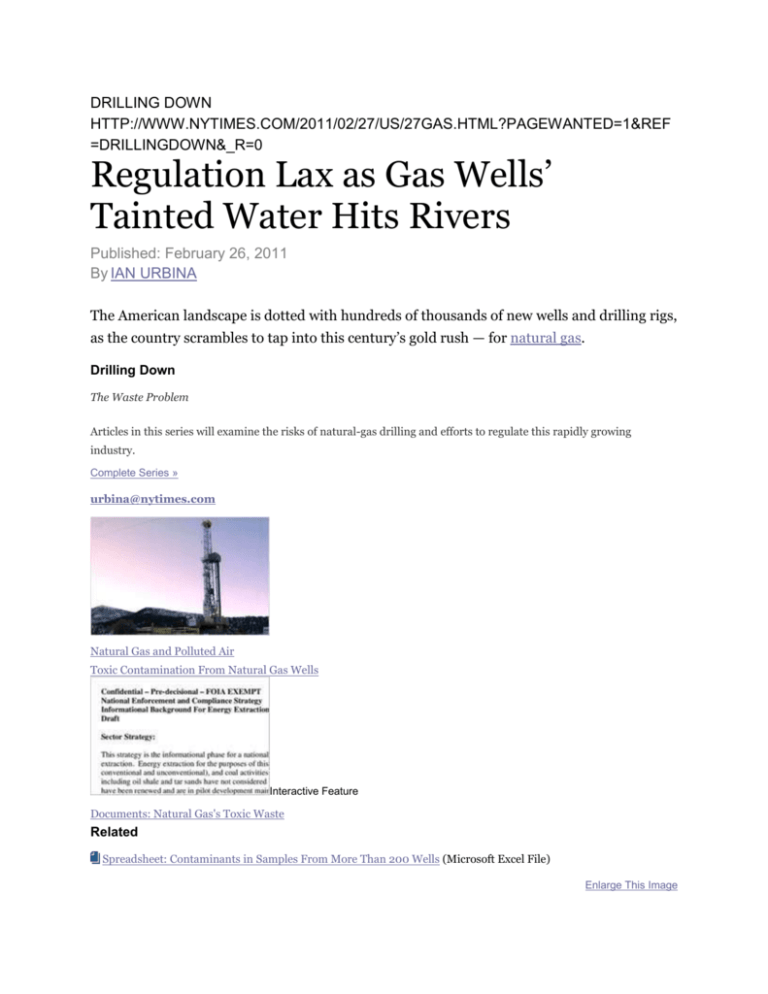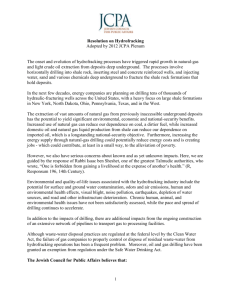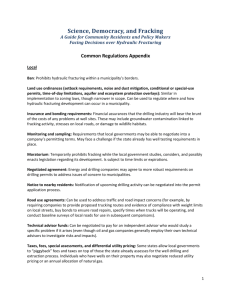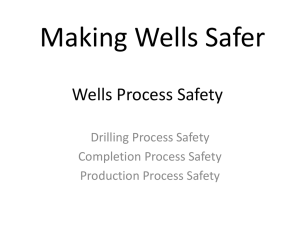DRILLING DOWN http://www.nytimes.com/2011/02/27/us/27gas.html
advertisement

DRILLING DOWN HTTP://WWW.NYTIMES.COM/2011/02/27/US/27GAS.HTML?PAGEWANTED=1&REF =DRILLINGDOWN&_R=0 Regulation Lax as Gas Wells’ Tainted Water Hits Rivers Published: February 26, 2011 By IAN URBINA The American landscape is dotted with hundreds of thousands of new wells and drilling rigs, as the country scrambles to tap into this century’s gold rush — for natural gas. Drilling Down The Waste Problem Articles in this series will examine the risks of natural-gas drilling and efforts to regulate this rapidly growing industry. Complete Series » urbina@nytimes.com Natural Gas and Polluted Air Toxic Contamination From Natural Gas Wells Interactive Feature Documents: Natural Gas's Toxic Waste Related Spreadsheet: Contaminants in Samples From More Than 200 Wells (Microsoft Excel File) Enlarge This Image Todd Heisler/The New York Times Thousands of wells like this one outside Pittsburgh extract gas by injecting huge amounts of water The gas has always been there, of course, trapped deep underground in countless tiny bubbles, like frozen spills of seltzer water between thin layers of shale rock. But drilling companies have only in recent years developed techniques to unlock the enormous reserves, thought to be enough to supply the country with gas for heating buildings, generating electricity and powering vehicles for up to a hundred years. So energy companies are clamoring to drill. And they are getting rare support from their usual sparring partners. Environmentalists say using natural gas will help slowclimate change because it burns more cleanly than coal and oil. Lawmakers hail the gas as a source of jobs. They also see it as a way to wean the United States from its dependency on other countries for oil. But the relatively new drilling method — known as high-volume horizontal hydraulic fracturing, or hydrofracking — carries significant environmental risks. It involves injecting huge amounts of water, mixed with sand and chemicals, at high pressures to break up rock formations and release the gas. With hydrofracking, a well can produce over a million gallons of wastewater that is often laced with highly corrosive salts, carcinogens like benzene and radioactive elements like radium, all of which can occur naturally thousands of feet underground. Other carcinogenic materials can be added to the wastewater by the chemicals used in the hydrofracking itself. While the existence of the toxic wastes has been reported, thousands of internal documents obtained by The New York Times from the Environmental Protection Agency, state regulators and drillers show that the dangers to the environment and health are greater than previously understood. The documents reveal that the wastewater, which is sometimes hauled to sewage plants not designed to treat it and then discharged into rivers that supply drinking water, contains radioactivity at levels higher than previously known, and far higher than the level that federal regulators say is safe for these treatment plants to handle. Other documents and interviews show that many E.P.A. scientists are alarmed, warning that the drilling waste is a threat to drinking water in Pennsylvania. Their concern is based partly on a 2009 study, never made public, written by an E.P.A. consultant who concluded that some sewage treatment plants were incapable of removing certain drilling waste contaminants and were probably violating the law. The Times also found never-reported studies by the E.P.A.and a confidential study by the drilling industry that all concluded that radioactivity in drilling waste cannot be fully diluted in rivers and other waterways. But the E.P.A. has not intervened. In fact, federal and state regulators are allowing most sewage treatment plants that accept drilling waste not to test for radioactivity. And most drinking-water intake plants downstream from those sewage treatment plants in Pennsylvania, with the blessing of regulators, have not tested for radioactivity since before 2006, even though the drilling boom began in 2008. In other words, there is no way of guaranteeing that the drinking water taken in by all these plants is safe. That has experts worried. “We’re burning the furniture to heat the house,” said John H. Quigley, who left last month as secretary of Pennsylvania’s Department of Conservation and Natural Resources. “In shifting away from coal and toward natural gas, we’re trying for cleaner air, but we’re producing massive amounts of toxic wastewater with salts and naturally occurring radioactive materials, and it’s not clear we have a plan for properly handling this waste.” The risks are particularly severe in Pennsylvania, which has seen a sharp increase in drilling, with roughly 71,000 active gas wells, up from about 36,000 in 2000. The level of radioactivity in the wastewater has sometimes been hundreds or even thousands of times the maximum allowed by the federal standard for drinking water. While people clearly do not drink drilling wastewater, the reason to use the drinking-water standard for comparison is that there is no comprehensive federal standard for what constitutes safe levels of radioactivity in drilling wastewater. Drillers trucked at least half of this waste to public sewage treatment plants in Pennsylvania in 2008 and 2009, according to state officials. Some of it has been sent to other states, including New York and West Virginia. Yet sewage treatment plant operators say they are far less capable of removing radioactive contaminants than most other toxic substances. Indeed, most of these facilities cannot remove enough of the radioactive material to meet federal drinking-water standards before discharging the wastewater into rivers, sometimes just miles upstream from drinking-water intake plants. In Pennsylvania, these treatment plants discharged waste into some of the state’s major river basins. Greater amounts of the wastewater went to the Monongahela River, which provides drinking water to more than 800,000 people in the western part of the state, including Pittsburgh, and to the Susquehanna River, which feeds into Chesapeake Bay and provides drinking water to more than six million people, including some in Harrisburg and Baltimore. Enlarge This Image Todd Heisler/The New York Times Wastewater, which can have radioactive contaminants and corrosive salts, is transferred from a holding pond to a truck. Drilling Down The Waste Problem Articles in this series will examine the risks of natural-gas drilling and efforts to regulate this rapidly growing industry. Natural Gas and Polluted Air Extracting Natural Gas From Rock Toxic Contamination From Natural Gas Wells Interactive Feature Documents: Natural Gas's Toxic Waste Spreadsheet: Contaminants in Samples From More Than 200 Wells (Microsoft Excel File) Follow@NYTNational for breaking news and headlines. Twitter List: Reporters and Editors Enlarge This Image Todd Heisler/The New York Times Much wastewater goes to treatment plants like this one at the Monongahela southeast of Pittsburgh, then into rivers. Lower amounts have been discharged into the Delaware River, which provides drinking water for more than 15 million people in Philadelphia and eastern Pennsylvania. In New York, the wastewater was sent to at least one plant that discharges into Southern Cayuga Lake, near Ithaca, and another that discharges into Owasco Outlet, near Auburn. In West Virginia, a plant in Wheeling discharged gas-drilling wastewater into the Ohio River. “Hydrofracking impacts associated with health problems as well as widespread air and water contamination have been reported in at least a dozen states,” said Walter Hang, president of Toxics Targeting, a business in Ithaca, N.Y., that compiles data on gas drilling. Problems in Other Regions While Pennsylvania is an extreme case, the risks posed by hydrofracking extend across the country. There were more than 493,000 active natural-gas wells in the United States in 2009, almost double the number in 1990. Around 90 percent have used hydrofracking to get more gas flowing, according to the drilling industry. Gas has seeped into underground drinking-water supplies in at least five states, including Colorado, Ohio, Pennsylvania, Texas and West Virginia, and residents blamed natural-gas drilling. Air pollution caused by natural-gas drilling is a growing threat, too. Wyoming, for example, failed in 2009 to meet federal standards for air quality for the first time in its history partly because of the fumes containing benzene and toluene from roughly 27,000 wells, the vast majority drilled in the past five years. In a sparsely populated Sublette County in Wyoming, which has some of the highest concentrations of wells, vapors reacting to sunlight have contributed to levels of ozone higher than those recorded in Houston and Los Angeles. Industry officials say any dangerous waste from the wells is handled in compliance with state and federal laws, adding that drilling companies are recycling more wastewater now. They also say that hydrofracking is well regulated by the states and that it has been used safely for decades. But hydrofracking technology has become more powerful and more widely used in recent years, producing far more wastewater. Some of the problems with this drilling, including its environmental impact and the challenge of disposing of waste, have been documented by ProPublica, The Associated Press and other news organizations, especially out West. And recent incidents underscore the dangers. In late 2008, drilling and coal-mine waste released during a drought so overwhelmed the Monongahela that local officials advised people in the Pittsburgh area to drink bottled water. E.P.A. officials described the incident in an internal memorandum as “one of the largest failures in U.S. history to supply clean drinking water to the public.” In Texas, which now has about 93,000 natural-gas wells, up from around 58,000 a dozen years ago, a hospital system in six counties with some of the heaviest drilling said in 2010 that it found a 25 percent asthma rate for young children, more than three times the state rate of about 7 percent.








